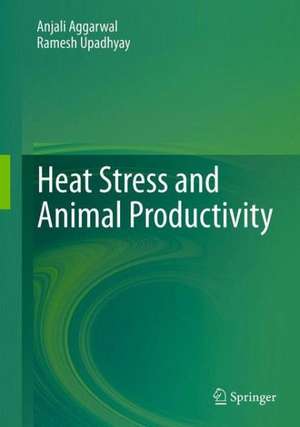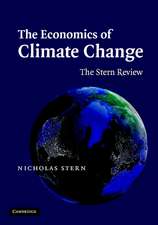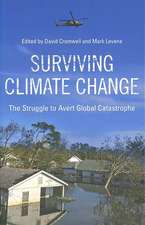Heat Stress and Animal Productivity
Autor Anjali Aggarwal, Ramesh Upadhyayen Limba Engleză Hardback – 28 dec 2012
| Toate formatele și edițiile | Preț | Express |
|---|---|---|
| Paperback (1) | 555.85 lei 38-44 zile | |
| Springer India – 23 aug 2016 | 555.85 lei 38-44 zile | |
| Hardback (1) | 649.87 lei 43-57 zile | |
| Springer India – 28 dec 2012 | 649.87 lei 43-57 zile |
Preț: 649.87 lei
Preț vechi: 764.55 lei
-15% Nou
Puncte Express: 975
Preț estimativ în valută:
124.39€ • 135.16$ • 104.56£
124.39€ • 135.16$ • 104.56£
Carte tipărită la comandă
Livrare economică 21 aprilie-05 mai
Preluare comenzi: 021 569.72.76
Specificații
ISBN-13: 9788132208785
ISBN-10: 8132208781
Pagini: 220
Ilustrații: XVIII, 188 p.
Dimensiuni: 178 x 254 x 15 mm
Greutate: 0.68 kg
Ediția:2013
Editura: Springer India
Colecția Springer
Locul publicării:New Delhi, India
ISBN-10: 8132208781
Pagini: 220
Ilustrații: XVIII, 188 p.
Dimensiuni: 178 x 254 x 15 mm
Greutate: 0.68 kg
Ediția:2013
Editura: Springer India
Colecția Springer
Locul publicării:New Delhi, India
Public țintă
ResearchCuprins
CHAPTER 1 Thermoregulation.- CHAPTER 2 Heat stress and Hormones.- CHAPTER 3 Heat Stress and Milk Production.- CHAPTER 4 Heat stress and Reproduction.- CHAPTER 5 Heat stress and immune function.- CHAPTER 6 Biological Rhythms.- CHAPTER 7 Shelter Management for Alleviation of Heat Stress in Cows and Buffaloes.
Notă biografică
Dr. Anjali Aggarwal
Dr. Anjali Aggarwal is working as a Senior Scientist at National Dairy Research Institute, Karnal (India). She holds a PhD degree in Animal Physiology and is involved in research and teaching at post-graduate level. Her area of research work is stress and environmental physiology. She has more than 50 publications, two technical bulletins, four manuals and many book chapters to her credit. She has successfully guided many post-graduate and PhD students.
Her major research accomplishments are on microclimatic modification for alleviation of heat and cold stress, mist and fan cooling systems for cows and buffaloes, and use of wallowing tank in buffaloes. Her work involves the use of technology of supplementing micronutrients during dry period and early lactation to crossbred and indigenous cows for alleviating metabolic and oxidative stress and improved health and productivity. Studies are also done in her lab on partitioning of heat loss from skin and pulmonary system of cattle and buffaloes as a result of exercise or exposure to heat stress.
Dr. R.C. Upadhyay
Dr. R.C. Upadhyay is working as Head, Dairy Cattle Physiology Division at National Dairy Research Institute, Karnal (India). He graduated in Veterinary Sciences and obtained his PhD degree in Animal Physiology. His area of recent research is climate change, stress, and environmental physiology. His major research accomplishment is on climate change impact assessment of milk production and growth in livestock. His work also involves studying methane conversion and emission factors for Indian livestock and use of IPCC methodology of methane inventory of Indian livestock. Heat shock protein-70 expression studies in cattle and buffaloes are also done in his lab. Draught animal power evaluation, fatigue assessment, work-rest cycle and work limiting factors form the highlights of his work. Studies on partitioning of heat loss from skin and pulmonary systemof cattle and buffaloes and electrocardiographic studies in cattle, buffalo, sheep and goat are also undertaken in his lab.
He has more than 75 research papers, four books and several book chapters to his credit. Technologies developed and research done by him include methodology of methane measurement: open and closed circuit for cattle and buffaloes; inventory of methane emission from livestock using IPCC methodology; livestock stress index: thermal stress measurement based on physiological functions; and draught power evaluation system and large animal treadmill system. He received training in Radio-nuclides in medicine at Australian School of Nuclear Technology, Lucas heights, NSW, Australia in 1985 and Use of radioisotopes in cardiovascular investigations at CSIRO, Prospect, NSW, Australia, during 1985-86. He has guided several post-graduate and PhD students. He is recipient of Hari Om Ashram Award-1990 (ICAR) for outstanding research in animal sciences.
Dr. Anjali Aggarwal is working as a Senior Scientist at National Dairy Research Institute, Karnal (India). She holds a PhD degree in Animal Physiology and is involved in research and teaching at post-graduate level. Her area of research work is stress and environmental physiology. She has more than 50 publications, two technical bulletins, four manuals and many book chapters to her credit. She has successfully guided many post-graduate and PhD students.
Her major research accomplishments are on microclimatic modification for alleviation of heat and cold stress, mist and fan cooling systems for cows and buffaloes, and use of wallowing tank in buffaloes. Her work involves the use of technology of supplementing micronutrients during dry period and early lactation to crossbred and indigenous cows for alleviating metabolic and oxidative stress and improved health and productivity. Studies are also done in her lab on partitioning of heat loss from skin and pulmonary system of cattle and buffaloes as a result of exercise or exposure to heat stress.
Dr. R.C. Upadhyay
Dr. R.C. Upadhyay is working as Head, Dairy Cattle Physiology Division at National Dairy Research Institute, Karnal (India). He graduated in Veterinary Sciences and obtained his PhD degree in Animal Physiology. His area of recent research is climate change, stress, and environmental physiology. His major research accomplishment is on climate change impact assessment of milk production and growth in livestock. His work also involves studying methane conversion and emission factors for Indian livestock and use of IPCC methodology of methane inventory of Indian livestock. Heat shock protein-70 expression studies in cattle and buffaloes are also done in his lab. Draught animal power evaluation, fatigue assessment, work-rest cycle and work limiting factors form the highlights of his work. Studies on partitioning of heat loss from skin and pulmonary systemof cattle and buffaloes and electrocardiographic studies in cattle, buffalo, sheep and goat are also undertaken in his lab.
He has more than 75 research papers, four books and several book chapters to his credit. Technologies developed and research done by him include methodology of methane measurement: open and closed circuit for cattle and buffaloes; inventory of methane emission from livestock using IPCC methodology; livestock stress index: thermal stress measurement based on physiological functions; and draught power evaluation system and large animal treadmill system. He received training in Radio-nuclides in medicine at Australian School of Nuclear Technology, Lucas heights, NSW, Australia in 1985 and Use of radioisotopes in cardiovascular investigations at CSIRO, Prospect, NSW, Australia, during 1985-86. He has guided several post-graduate and PhD students. He is recipient of Hari Om Ashram Award-1990 (ICAR) for outstanding research in animal sciences.
Textul de pe ultima copertă
The book is on livestock with specific reference to heat stress and its alleviation. The topic is very pertinent in light of the impacts of climate change on livestock production and health. Work related to effect of heat stress on animal productivity, immunity and hormonal levels is discussed in detail. Heat stress occurs in animals when there is an imbalance between heat production within the body and its dissipation. Thermoregulation is the means by which an animal maintains its body temperature. Under heat stress, a number of physiological and behavioral responses vary in intensity and duration in relation to the animal genetic make-up and environmental factors. In response to stress, mammals set physical, biochemical, and physiological processes into play to try and counteract the negative effects of heat stress and maintain thermal equilibrium.
Adaptation to heat stress requires the physiological integration of many organs and systems viz. endocrine, cardiorespiratory and immune system. Heat stress also lowers natural immunity making animals more vulnerable to disease in the following days and weeks. The decrease in fertility is caused by elevated body temperature that influences ovarian function, estrous expression, oocyte health, and embryonic development.
The increasing concern with the thermal comfort of dairy cows is justifiable not only for countries occupying tropical zones, but also for nations in temperate zones in which high ambient temperatures are becoming an issue. Improving milk production is, therefore, an important tool for improving the quality of life particularly for rural people in developing countries. The environmental conditions necessitate reduction of heat stress due to solar radiation and heat.
The book discusses all these aspects in detail. Recent works related to effect of heat stress on animal productivity, immunity and hormonal levels are also discussed in the book. Information on biological rhythm is also included. The book also discusses the methods for alleviation of heat stress in livestock, especially cows and buffaloes. It is be a ready reckoner for students, researchers, and academia and would pave way for further research.
Adaptation to heat stress requires the physiological integration of many organs and systems viz. endocrine, cardiorespiratory and immune system. Heat stress also lowers natural immunity making animals more vulnerable to disease in the following days and weeks. The decrease in fertility is caused by elevated body temperature that influences ovarian function, estrous expression, oocyte health, and embryonic development.
The increasing concern with the thermal comfort of dairy cows is justifiable not only for countries occupying tropical zones, but also for nations in temperate zones in which high ambient temperatures are becoming an issue. Improving milk production is, therefore, an important tool for improving the quality of life particularly for rural people in developing countries. The environmental conditions necessitate reduction of heat stress due to solar radiation and heat.
The book discusses all these aspects in detail. Recent works related to effect of heat stress on animal productivity, immunity and hormonal levels are also discussed in the book. Information on biological rhythm is also included. The book also discusses the methods for alleviation of heat stress in livestock, especially cows and buffaloes. It is be a ready reckoner for students, researchers, and academia and would pave way for further research.
Caracteristici
The book underlines the recent research on the topic of heat stress and animal productivity Effect of the phenomenon of climate change on the animal productivity has been discussed in detail The book increasingly looks for the solutions for combating the effects of climate-induced temperature rise on animals New and advanced strategies for ameliorating heat stress are discussed in detail










